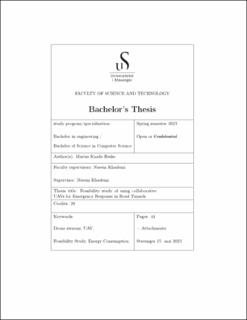| dc.contributor.advisor | Khademi, Naeem | |
| dc.contributor.author | Hesk, Marius Kaada | |
| dc.date.accessioned | 2023-07-07T15:51:26Z | |
| dc.date.available | 2023-07-07T15:51:26Z | |
| dc.date.issued | 2023 | |
| dc.identifier | no.uis:inspera:130505068:56707460 | |
| dc.identifier.uri | https://hdl.handle.net/11250/3077143 | |
| dc.description.abstract | Utilizing UAVs for assisting in emergency response missions is already a fact, both in open landscapes like forests and in restricted areas like sewers. However, using them in road tunnels has not yet been realised, and could possibly provide a huge help for the first responders in the form of surveillance, providing network coverage or announcing self-help assistance to the victims. There are certain challenges for this to be possible, some of them being lack of signal coverage, battery life and positional navigation in a GPS-denied environment. In this thesis the feasibility of this will be put into consideration by surveying available software and hardware for this utilization, as well as setting up a generalised energy consumption model to check where the different drone configurations can be used. The results implies that the state-of-the-art drone configurations are very capable of being used to assist in emergency situations in road tunnels, both when it comes to response time and length coverage. However, the main restricting factor will be cost, as modern drone swarm configurations with a reasonable battery capacity and sophisticated sensors comes at a high cost. | |
| dc.description.abstract | Utilizing UAVs for assisting in emergency response missions is already a fact, both in open landscapes like forests and in restricted areas like sewers. However, using them in road tunnels has not yet been realised, and could possibly provide a huge help for the first responders in the form of surveillance, providing network coverage or announcing self-help assistance to the victims. There are certain challenges for this to be possible, some of them being lack of signal coverage, battery life and positional navigation in a GPS-denied environment. In this thesis the feasibility of this will be put into consideration by surveying available software and hardware for this utilization, as well as setting up a generalised energy consumption model to check where the different drone configurations can be used. The results implies that the state-of-the-art drone configurations are very capable of being used to assist in emergency situations in road tunnels, both when it comes to response time and length coverage. However, the main restricting factor will be cost, as modern drone swarm configurations with a reasonable battery capacity and sophisticated sensors comes at a high cost. | |
| dc.language | eng | |
| dc.publisher | uis | |
| dc.title | Thesis title: Feasibility study of using collaborative UAVs for Emergency Response in Road Tunnels | |
| dc.type | Bachelor thesis | |
